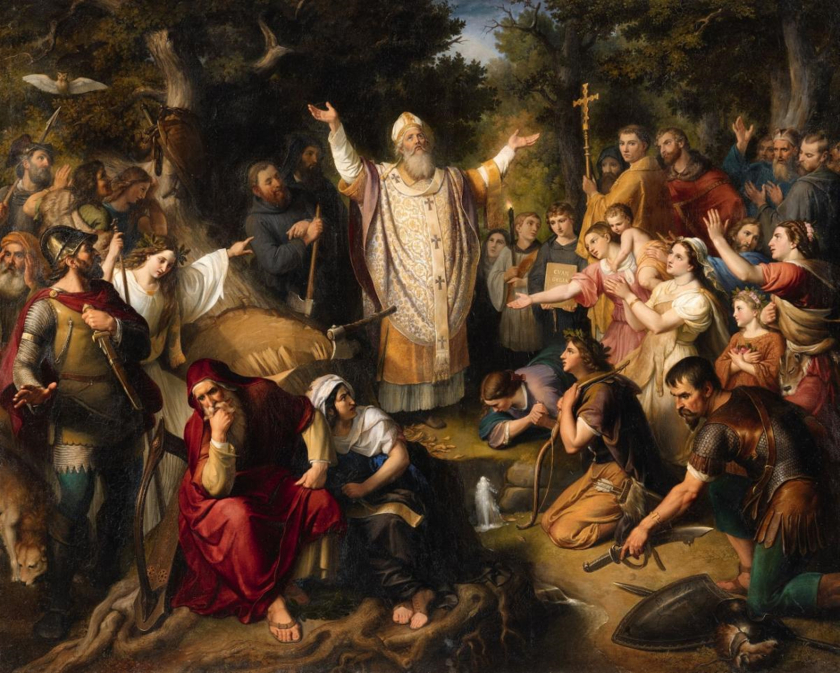Saint of the Day – 5 June – St Boniface (672-754) Martyr – Bishop/Archbishop, Missionary and Evangelist, Teacher, Writer, Preacher, Theologian, Founder of Schools, Convents, Monasteries and Churches – known as “The Apostle of Germany.” Patron of brewers, file cutters, tailors, Germany, Archdiocese of Saint-Boniface, Manitoba, Canada, diocese of Fulda, Germany. 
Boniface, known as the Apostle of the Germans, was an English Benedictine Monk who gave up being elected Abbot to devote his life to the conversion of the Germanic tribes. Two characteristics stand out: his Christian orthodoxy and his fidelity to the Pope of Rome.
How absolutely necessary this orthodoxy and fidelity were, is borne out by the conditions Boniface found on his first missionary journey in 719 at the request of Pope Gregory II. Paganism was a way of life. What Christianity he did find, had either lapsed into paganism or was mixed with error. The clergy were mainly responsible for these latter conditions since they were in many instances uneducated, lax and questionably obedient to their bishops. In particular instances their very ordinations were questionable.
These are the conditions that Boniface was to report in 722 on his first return visit to Rome. The Holy Father instructed him to reform the German Church. The pope sent letters of recommendation to religious and civil leaders. Boniface later admitted that his work would have been unsuccessful, from a human viewpoint, without a letter of safe-conduct from Charles Martel, the powerful Frankish ruler, grandfather of Charlemagne. Boniface was finally made a regional bishop and authorised to organise the whole German Church. He was eminently successful.
In the Frankish kingdom, he met great problems because of lay interference in bishops’ elections, the worldliness of the clergy and lack of papal control.
In order to restore the Germanic Church to its fidelity to Rome and to convert the pagans, Boniface had been guided by two principles. The first was to restore the obedience of the clergy to their bishops in union with the pope of Rome. The second, was the establishment of many houses of prayer which took the form of Benedictine monasteries. A great number of Anglo-Saxon monks and nuns followed him to the continent, where he introduced the Benedictine nuns to the active apostolate of education.
For nearly 35 years, Boniface traveled all over Germany, preaching, teaching, and building schools, monasteries, and convents. He went to Rome to report to the pope about his work. There, the pope ordained him bishop and told him to return to Germany to continue missionary work. Boniface invited monks and sisters from England to come and help him. The monastery at Fulda is probably the most famous one started by Boniface, below is the Cathedral and a Statue of him there.
During a final mission to the Frisians, Boniface and 53 companions were massacred while he was preparing converts for confirmation by a band of angry natives. who rushed into the church and murdered them. Today Saint Boniface is the patron of Germany.

St Boniface & the Christmas Tree
It is told that Saint Boniface, one day came upon a group of pagans gathered around a big oak tree about to sacrifice a child to the god Thor, which was represented by the tree. To stop the sacrifice and save the child’s life Boniface felled the tree with one mighty blow of his fist. Nearby grew a small fir tree. The saint told the pagan worshippers that the tiny fir was the Tree of Life and stood for the eternal life of Christ . Saint Boniface also used the triangular shape of the fir tree to describe the Holy Trinity of God the Father, Son and Holy Ghost. By the 12th Century, Christmas trees were used all over Europe as a symbol of Christianity.


More info on St Boniface here: https://anastpaul.wordpress.com/2017/06/05/saint-of-the-day-5-june-st-boniface/



4 thoughts on “Saint of the Day – 5 June – St Boniface (672-754) Martyr “The Apostle of Germany””